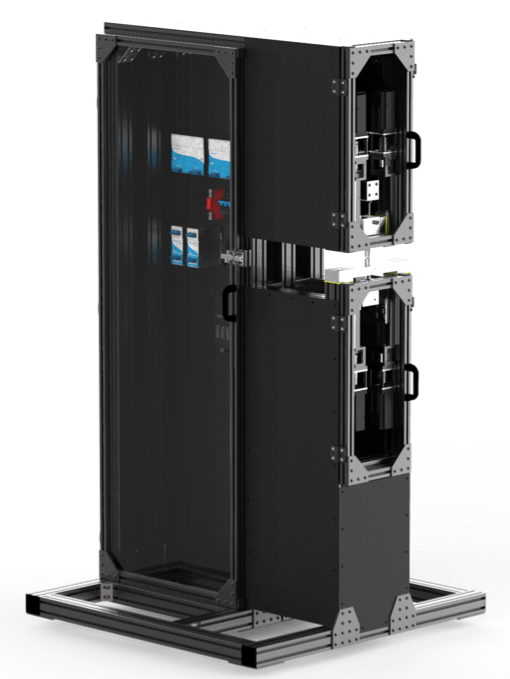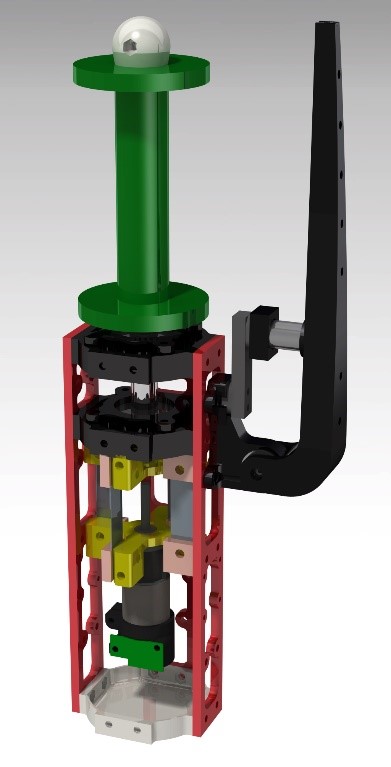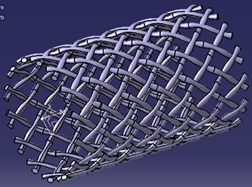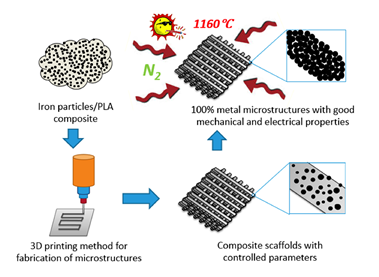Manufacturing composites matrial using pultrusion allows to produce profiles of various geometries continuously.
This process is promising because its adapted to large-scale production, a major challenge of composite materials. The current researchs tackle the improvement of the impregnation of the thermoplastic resin due to its high viscosity.
At the same time, the prospect of the deplection of oil ressources and environmental issues are now directing manufacturing industry towards cleaner products made from petrochemical free derivatives. Bio composites are a relevant response to these chalenges.
Félix Lapointe (Ph.D, Done)
Pultrusion is an automated manufacturing technique allowing production of composites tubes and profiles. To this date, the pultrusion of composites with a thermoset matrix have been widely used in industry. On the other hand, few pultruded products use thermoplastic matrices. The high viscosity of these matrices makes the impregnation of the fibers difficult and time consuming, making this fabrication technique not profitable for large series. The main challenge is to increase production speed without entrapping air in the pultruded part. This research project objective is to produce carbon/peek pultruded rods having with low porosity levels.
Vincent Fortier (Ph.D, Done)
Composite material manufacturing by pultrusion enables the continuous production of a wide variety of constant cross-section beams. In order to pultrude thermoplastic composites, the temperature must be controlled precisely along the pultrusion system. Different temperature profiles can be used depending of the type of polymer matrix. A LabVIEW program is developed to regulate the cartridge heater alimentation with thermocouples.This system can be adapted to different manufacturing conditions.
Arnold Oswald (M.Sc.A, Done)
Composite material manufacturing by pultrusion enables the continuous production of a wide variety of constant cross-section beams. Its potential in terms of mass production, a major challenge for the development of composites, makes it a promising solution. However, the control of the fibres impregnation process with thermoplastic matrices still needs improvement due their high viscosity. In parallel, the prospect of oil scarcity and environmental issues are pushing manufacturing industries toward more eco-friendly products, made from material other than petrochemical by-products. Development of composites made from renewable sources – « biocomposites » – shapes a relevant answer to both challenges, making those materials an attractive alternative for industries. The project will first set-up a functional and modular pultrusion system using a new impregnation technical solution. The system will then be used to conduct an experimental study on the manufacture of unidirectional biofibre reinforced beams.
Philippe Monnot (B.Ing, Done)
The mandate was to design partially a pultrusion system for thermoplastic composites. This manufacturing process allows the continuous shaping of cylindrical or profiled shape plastic parts reinforced with continuous fibers. Based on the initial specifications provided and using the axiomatic design methodology, the design consists of seven individual modules. Their main functions are the heating, shaping, and cooling of the composite. Modules allow the adaptation of the pultrusion system configuration for given manufacturing conditions. This will give researchers the flexibility to develop new advanced materials.
Christophe Absi (DESS, On track)
Composite materials are used in aeronautical structures for their high specific properties. However, it can be difficult to join these composite parts together. Indeed, composites can not withstand the highly localized loads caused by the deformation of metal rivets traditionally used in metal structures. Titanium fasteners are currently used in the aerospace industry. However, this solution has disadvantages in terms of weight, lightning and cost. It is to overcome these problems that C/PEEK rivets are proposed. A riveting machine for composite rivets was manufactured and the riveted joints were tested for shear and tension. The results showed very high specific properties that would allow this technology to be applied to the next generation of lighter, greener and safer aircraft.
Christophe Absi (B.Ing, Done)
An innovative joining technology using thermoplastic matrix composite rivets has been developed to replace the titanium fasteners currently used in aeronautical composite structures. However, since the first iteration of the machine was not automatic and unable to apply large forces, the manufacturing of C/PEEK rivets was not possible. This project resulted in a machine housing five 1000 N actuators, capable of applying a consolidation pressure of 50 MPa. With this automated machine, it is possible to make C/PEEK rivets in less than a minute.
The ACFSLab has developed an expertise in the field of fibre braiding for aeronautical applications.
Cristian Stéfan Talos (M.Sc.A, On track)
Composite braiding machines currently have carriers that provide an approximate level of tension in the composite fibre during braiding using a screw and a spring pulley system. This purely mechanical system does not review data on braiding quality and does not provide constant tension throughout the braiding process. The invention consists in substituting the purely mechanical system with an electromechanical system, either with integrated electronics and a motor controlled by a torque sensor used as control feedback. The new system would be able to collect data and send them in real time to a control station, thus allowing monitoring and adjustment throughout the robotic braiding process. This new procedure would allow the fibre to be rewound if necessary for long distance movements of the carrier during braiding and could also allow 3D composite braiding by adjusting a variable tension in the fibre in real time.
Marc Gondran (M.Sc.A, Finished)
Braiding is a textile preforming process used in the aeronautical industry. Carriers arranged on the circular track of the braiding machine rotate in opposite directions while in the braiding machine center, the mandrel representing the counterpart of the part to be manufactured advances. The combined movement of the mandrel and the carriers allows the yarns to be braided over the mandrel. The process is automated and therefore repeatable, and the deposition of tens or even hundreds of yarns simultaneously gives excellent productivity. The braided textile also has excellent impact resistance. The mechanical properties of the braided parts are function of the braiding angle formed by the yarns. The knowledge of the braiding behaviour and the link between the take-off speed and braiding angle is sparse in the literature. The work presented in this thesis aims to model this link and to implement it in a research laboratory context.
Numerous researches available in the literature have tried to model the link between the braiding angle and the take-off speed of the mandrel. For circular mandrels, analytical relationships exist. For complex mandrels though, models have been published but they have limitations either in accuracy or in processing time.
The primary objective is to develop a new approach to solve the inverse problem which aims at identifying the manufacturing parameters that result in the targeted braiding angle with better accuracy while reducing the processing time.
The second objective is to develop and implement, at the industrial partner's lab, the post- processor enabling the link between the computer model and the production tool. Thanks to this, the experiments can be carried out in order to validate the model.
The results show the validity of the approach and the error between the targeted braiding angle and the measured angle limited to 0.87° on all the measurements carried out while the quality threshold is generally set at 1° in the industry.
This work has been published in Composites Part A : Applied Sciences and Manufacturing (Available here)
 Philippe Monnot (M.Sc.A, Done)
Philippe Monnot (M.Sc.A, Done)
Unlike other composite manufacturing processes, braiding allows a precise control of the reinforcing fibres orientation at any point of the structure. Advanced structures can be braided using structural fibres since the braided fabrics have an excellent capacity to adapt to complex tubular shapes. Braiding can be used in the aerospace industry to build composite structures such as aircraft fuselage frames. However, understanding of the process and its limitation is needed in order to increase the use of this technique in the industry. Automated braiding will help reduce manufacturing costs without sacrificing mechanical properties.
 DongQiao Yang (M.Sc.A, Done)
DongQiao Yang (M.Sc.A, Done)
The use of carbon fiber in the automotive and aerospace market is growing because of the price reduction of the raw materials. On the other side, the structural applications in these markets also require low- cost manufacturing processes. The braiding and pultrusion process is very promising; it allows the manufacturer to produce structural frame continuously. However, this method causes many deformations in the braid during the process. Therefore, the objective of this project is to create a 3D parametric model of the braid, whose parameters are generated from the geometry of the components (eg , Nb. Fibers, volume fraction, ... ) using a Matlab code. In sum, this parametric model will allow us to visualize the braid under different stresses and strains, and it will be validated with experimental data.
Cedric Leblond-Ménard (Ph.D, Done) and Frédérik Coallier (Ph.D, Done)
The project goal is to conceive a 3D structure printing system assisted by radiation. The printing is done by extruding a viscous solution of metal particles in a polymer through a syringe attached to a robotized printing head. A radiation source is pointed at the extruded mix, increasing its temperature and sintering the metal particles contained in it, forming a solid filament. This process allows the printing of tridimensional structures without the use of extruded supports. The spectrum of use of the process are found in the protection of critical electronic components such as micro rf-shields (Faraday cages), fast prototyping of conductors or metallic objects, etc.
 Chao Xu (Ph.D, Done)
Chao Xu (Ph.D, Done)
The project involves the development of a novel 3D printing (or direct-writing fabrication) method for metallic inks. The ink is a mixture of metallic micro- or nano- powder and a UV curable polymer. During the ink printing, the material is exposed to UV light in order to facilitate the curing process and shape retention to achieve complex 3D shapes. The percentage of the metallic powder will be progressively increased in order to reach a 100% metallic structure with low porosity or defects.
 Thierry Stocco (Ph.D, Done)
Thierry Stocco (Ph.D, Done)
With the increasing use of composites in civil aviation, thermoplastic composites have become an interesting material choice for repeating part numbers such as fuselage brackets. The simple L-shaped bracket geometry can be mass-produced using stamp-forming manufacturing. When subjected to opening loads, out-of-plane stresses, i.e., interlaminar tensile stresses, develop in the 90° corner radius. Those gradually increasing stresses ultimately lead to delamination failure. The interlaminar tensile strength is measured on a curved beam using a four-point bending apparatus (ASTM D6415) to create an opening load. However, models to related the curved beam strength of the composite to the interlaminar tensile stresses are still in development. In this study, a finite element model of the ASTM D6415 test is created to calculate the out-of-plane stresses in the radius of a curved composite bracket.
 Guillaume Carré (Ph.D, Done)
Guillaume Carré (Ph.D, Done)
Reception testing is made on composite materials at Bombardier Aerospace to insure that the materials comply with the manufacturer’s specifications. The compression testing coupons must be stabilized with tabs to avoid buckling according to the test specification SRM-01. The tabs are bonded to the panel using a bonding jig that insures proper positioning. After two years of usage, the manufacturing jig currently available at Bombardier Aerospace has worn off and the quality of the coupons is at risk. The project’s goal is to design a new jig with improved features.


